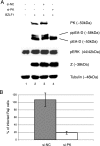Epstein-Barr virus-encoded protein kinase (BGLF4) is involved in production of infectious virus
- PMID: 17360761
- PMCID: PMC1900237
- DOI: 10.1128/JVI.02398-06
Epstein-Barr virus-encoded protein kinase (BGLF4) is involved in production of infectious virus
Abstract
The Epstein-Barr virus (EBV) BGLF4 gene product is a protein kinase (PK). Although this kinase has been characterized and several of its targets have been identified, its biological role remains enigmatic. We have generated and assessed a BGLF4 knockdown phenotype by means of RNA interference and report the following: (i) BGLF4-targeting small interfering RNA effectively inhibited the expression of its product, the viral PK, during lytic reactivation, (ii) BGLF4 knockdown partially inhibited viral DNA replication and expression of selected late viral genes, (iii) the absence of EBV PK resulted in retention of the viral nucleocapsids in the nuclei, and (iv) as a result of the nuclear retention, release of infectious virions is significantly retarded. Our results provide evidence that EBV PK plays an important role in nuclear egress of the virus and ultimately is crucial for lytic virus replication.
Figures



Similar articles
-
BGLF4 kinase modulates the structure and transport preference of the nuclear pore complex to facilitate nuclear import of Epstein-Barr virus lytic proteins.J Virol. 2015 Feb;89(3):1703-18. doi: 10.1128/JVI.02880-14. Epub 2014 Nov 19. J Virol. 2015. PMID: 25410863 Free PMC article.
-
Epstein-Barr Virus BKRF4 Gene Product Is Required for Efficient Progeny Production.J Virol. 2017 Nov 14;91(23):e00975-17. doi: 10.1128/JVI.00975-17. Print 2017 Dec 1. J Virol. 2017. PMID: 28904200 Free PMC article.
-
Epstein-Barr virus protein kinase BGLF4 targets the nucleus through interaction with nucleoporins.J Virol. 2012 Aug;86(15):8072-85. doi: 10.1128/JVI.01058-12. Epub 2012 May 23. J Virol. 2012. PMID: 22623767 Free PMC article.
-
Latent and lytic Epstein-Barr virus replication strategies.Rev Med Virol. 2005 Jan-Feb;15(1):3-15. doi: 10.1002/rmv.441. Rev Med Virol. 2005. PMID: 15386591 Review.
-
Conquering the Nuclear Envelope Barriers by EBV Lytic Replication.Viruses. 2021 Apr 18;13(4):702. doi: 10.3390/v13040702. Viruses. 2021. PMID: 33919628 Free PMC article. Review.
Cited by
-
A Mechanism-Based Targeted Screen To Identify Epstein-Barr Virus-Directed Antiviral Agents.J Virol. 2020 Oct 14;94(21):e01179-20. doi: 10.1128/JVI.01179-20. Print 2020 Oct 14. J Virol. 2020. PMID: 32796077 Free PMC article.
-
Maribavir inhibits Epstein-Barr virus transcription through the EBV protein kinase.J Virol. 2013 May;87(9):5311-5. doi: 10.1128/JVI.03505-12. Epub 2013 Feb 28. J Virol. 2013. PMID: 23449792 Free PMC article.
-
Development of drugs for Epstein-Barr virus using high-throughput in silico virtual screening.Expert Opin Drug Discov. 2010 Dec;5(12):1189-203. doi: 10.1517/17460441.2010.524640. Expert Opin Drug Discov. 2010. PMID: 22822721 Free PMC article.
-
Integrative profiling of Epstein-Barr virus transcriptome using a multiplatform approach.Virol J. 2022 Jan 6;19(1):7. doi: 10.1186/s12985-021-01734-6. Virol J. 2022. PMID: 34991630 Free PMC article.
-
Herpesviruses remodel host membranes for virus egress.Nat Rev Microbiol. 2011 May;9(5):382-94. doi: 10.1038/nrmicro2559. Nat Rev Microbiol. 2011. PMID: 21494278 Review.
References
-
- Asai, R., A. Kato, K. Kato, M. Kanamori-Koyama, K. Sugimoto, T. Sairenji, Y. Nishiyama, and Y. Kawaguchi. 2006. Epstein-Barr virus protein kinase BGLF4 is a virion tegument protein that dissociates from virions in a phosphorylation-dependent process and phosphorylates the viral immediate-early protein BZLF1. J. Virol. 80:5125-5134. - PMC - PubMed
-
- Baer, R., A. T. Bankier, M. D. Biggin, P. L. Deininger, P. J. Farrell, T. J. Gibson, G. Hatfull, G. S. Hudson, S. C. Satchwell, C. Seguin, et al. 1984. DNA sequence and expression of the B95-8 Epstein-Barr virus genome. Nature 310:207-211. - PubMed
-
- Biron, K. K., R. J. Harvey, S. C. Chamberlain, S. S. Good, A. A. Smith III, M. G. Davis, C. L. Talarico, W. H. Miller, R. Ferris, R. E. Dornsife, S. C. Stanat, J. C. Drach, L. B. Townsend, and G. W. Koszalka. 2002. Potent and selective inhibition of human cytomegalovirus replication by 1263W94, a benzimidazole l-riboside with a unique mode of action. Antimicrob. Agents Chemother. 46:2365-2372. - PMC - PubMed
-
- Chee, M. S., G. L. Lawrence, and B. G. Barrell. 1989. Alpha-, beta- and gammaherpesviruses encode a putative phosphotransferase. J. Gen. Virol. 70:1151-1160. - PubMed
Publication types
MeSH terms
Substances
Grants and funding
LinkOut - more resources
Full Text Sources

